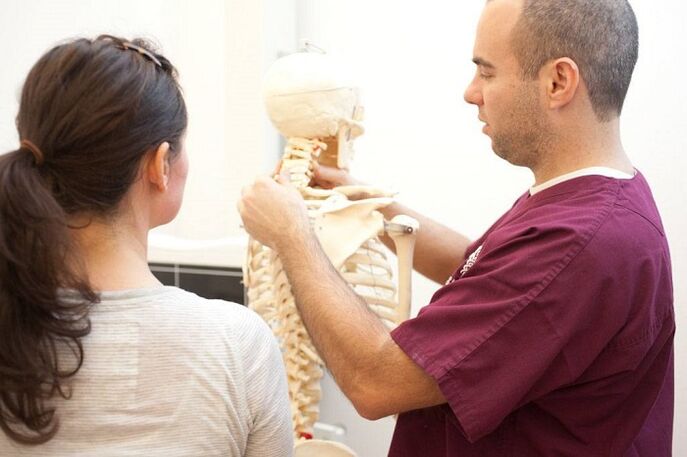Osteochondrosis of the cervical spine belongs to the category of long-term chronic diseases. In the development process of the disease, the destruction of the intervertebral space occurs which, if left untreated, inevitably leads to the formation of a herniated disc. In the modern world, both the elderly and children suffer from osteochondrosis. At the same time, the healing process takes months, or even years, and does not always guarantee a positive result. Thus, this problem must be addressed very seriously, because the sooner the doctor determines the presence of cervical osteochondrosis and prescribes the treatment, the more chances the patient will have to regain health.

The disease in question has quite characteristic manifestations, so it will be difficult not to notice them. However, before considering information on how to determine cervical osteochondrosis, it is necessary to know what its symptoms are and the factors responsible for its occurrence.
Osteochondrosis is a chronic disease that causes the onset of degenerative processes in the connective cartilage tissue located between the individual vertebrae. The progression of the disease disrupts the normal functioning of the body and can lead to disability. At the same time, destructive processes cause inflammation, which is transmitted to the nerve fibers that pass nearby. This development of events leads to muscle spasms, which exercise excessively, trying to avoid compressing blood vessels and nerve roots.
However, without external intervention, the body cannot deal with the disease and, as a result, a narrowing of the gap between individual vertebrae, along with other consequences of osteochondrosis, will lead to significant difficulty in blood circulation, and the human brain will not receiving oxygen and important nutrients in the necessary amounts. Of course, this will immediately affect the patient's self-awareness, so osteochondrosis can be determined by a number of characteristic symptoms.
The main symptoms
The most typical symptoms are:
- constant pain in the neck and head;
- regular bouts of nausea, sometimes vomiting;
- sharp and sudden changes in blood pressure;
- dizziness, fainting.
As you can see, the symptoms are very specific and impossible to miss, so it won't be difficult to determine osteochondrosis in the neck region. However, only an experienced neurologist should make the diagnosis, as this disease affects the work of many functions and during the examination it is necessary to draw an accurate picture of what is going on in order to prescribe the most effective course of treatment.

To determine the nature of the course of osteochondrosis of the cervical vertebrae, the patient is referred for radiography and computed tomography. In some cases, an ultrasound may be prescribed. As a rule, this occurs with complaints of chest pain in the context of absent cardiac pathology.
The manifestation of cardiac pain in a patient with neck osteochondrosis indicates the active spread of the disease along the spine. Such a symptom is rare, so the neurologist will definitely send the patient first for examination by a cardiologist, who should identify heart problems or confirm their absence. If the functioning of the cardiac system is undisturbed, then there is nothing to worry about, as osteochondrosis itself does not in any way affect the activity of such an important organ as the heart.
The above symptoms appear within the first few weeks of disease onset. The only exceptions are dizziness and nausea, as these unpleasant sensations are found in patients in stages 2-3 of disease development.
In total, there are three stages of disease development, the third of which manifests itself in the most insidious way. If you do not treat osteochondrosis of the neck vertebrae, your transition to a severe form will disrupt the normal functioning of many vital systems in the human body.
Prerequisites for the onset of osteochondrosis
Many factors are considered manifestations of osteochondrosis of the neck spine. However, the main one is the incorrect posture of the spine. Therefore, it is extremely important to create some kind of habit to maintain the correct body posture during work and rest from childhood.
The second very significant factor is called sedentary lifestyle. A modern person often complains about the lack of time to practice sports, but at the same time he can spend a lot of time thoughtlessly surfing the waves of the Internet, empty communication on social networks or computer games.

Since childhood, most people have reported the great benefits of simple morning exercise. However, few moderns do, although simple exercise in the morning can stimulate blood circulation, experience a real surge of liveliness, and help create a good mood throughout the day. In addition, morning exercise will keep your joints healthy and mobile for many years to come.
The last serious factor that causes osteochondrosis of the spine in the neck region, and at the same time many other problems, is lack of vitamins. Normally, the human body is deficient in vitamins in winter and early spring, so during these times you should eat as much raw vegetables and fruits as possible or buy vitamin complexes that are sold at any drugstore. You should also pay attention to other trace elements important to the body. By the way, many people mistakenly believe that osteochondrosis arises from a lack of calcium. This is not the case, although calcium should be used in the treatment of the disease, as it promotes the rapid healing of cartilage tissue.
The main stages of osteochondrosis
As you can see, osteochondrosis has a very pronounced symptomatology, however, in the initial stage, many people simply ignore the signs of impending disaster. It is extremely important to be vigilant and identify the disease in its first weak manifestations in time.
As a rule, the neuropathologist's patients are people whose osteochondrosis has already moved into the second stage of its development. This makes the healing process difficult, as it is possible to fight the disease effectively only in the initial phase.

Don't forget that osteochondrosis is one of the most difficult back conditions. It can have a negative impact on the work of several vital systems at once. If you do not seek professional help in a timely manner, then, as a result, you may get an illness that will lead to the formation of a spinal hernia, where only surgical intervention will correct the situation.
The osteochondrosis recovery process takes a long time and can only be successful with strict compliance with all the doctor's prescriptions. In no case should you independently diagnose and prescribe treatment, as you can further aggravate the situation.
Many believe that osteochondrosis is the final sentence and it is impossible to fully recover from it. In fact, this will not happen if the disease has not progressed to the final stage of development. In other cases, the situation can be corrected, but for that you need to focus on long, hard work and, in addition, you will have to change your lifestyle, making sport and outdoor activities an integral part.

























